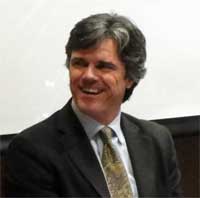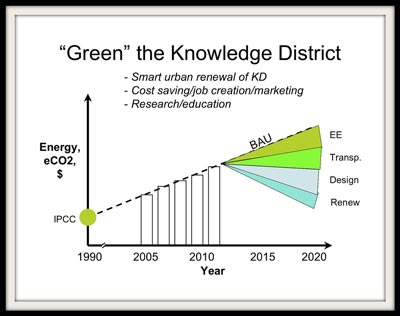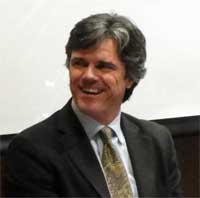Scientists, government, business and higher education officials met at Brown University’s Laboratories for Molecular Medicine for a presentation called, “Green the Knowledge District,” which addressed urban innovation, sustainability and economic development.
 S. Bradley Moran, URI professor of oceanography, co-chairs the energy and environment initiative for the area of Providence formerly known as the Jewelry District, along with Len Polizzotto, vice president for strategic business development and marketing for Draper Laboratory, Cambridge, Mass.
S. Bradley Moran, URI professor of oceanography, co-chairs the energy and environment initiative for the area of Providence formerly known as the Jewelry District, along with Len Polizzotto, vice president for strategic business development and marketing for Draper Laboratory, Cambridge, Mass.
“We want to catalyze economic development in the district through environmentally sustainable development,” Moran said. “Starting this spring, we are going to collect data on all the buildings in the district to develop a baseline audit. If we develop data that can lead to a sustainable district, companies are going to want to be there. It will be the cool place to be.”
Moran, a resident of Kingston, and Polizzotto joined U.S. Sen. Sheldon Whitehouse, Clyde L. Bryant, vice president of research for Brown University, Nick Bowen, vice president of technology at IBM, Brown President Ruth Simmons, URI President David M. Dooley, David Cicilline, former mayor of Providence and now U.S. congressman and Mayor-Elect Angel Tavares among others.
The Ocean State Consortium of Advanced Resources, known as OSCAR, is a volunteer organization consisting of government, industry, academic and social agencies across the region that is designed to address regional challenges that no one organization or institution could tackle alone.
Moran said Brown and URI would use teams of students to collect data on buildings in the district. “Brown is already doing much of that with its buildings in the district, and we would like to add to that data with analyses for example of Women and Infants Hospital, the Lifespan hospitals, the former Coro Vendome jewelry factory, and other buildings in the district,” Moran said.
Moran said about six undergraduate students would work under the supervision of Marion Gold, director of URI’s Cooperative Energy Center.
Eventually, the findings would be turned over to consultants such as NORESCO, one of the nation’s leading energy services companies. Moran calculated the carbon footprint of URI (http://www.uri.edu/research/tro/executive/uriacupccrept.pdf), which led to an $18 million contract with NORESCO. Through that work, URI has reduced electricity use on campus by nearly 9 million kilowatthours, 14,000 gallons of heating oil, and about 750,000 cubic feet of natural gas. It has reduced carbon dioxide emissions from campus operations by 18 million pounds and nitrous oxide emissions by 16,000 pounds.
“URI can be a great model for a city, since we have a self-contained community that has all of the components of a city, including close to 19,000 students, faculty and staff.”
Moran said the trail that led him to working with OSCAR began in 2006 when he and Mark Higgins, dean of URI’s College of Business Administration, worked to develop a combined master’s degree in business administration and oceanography, dubbed the “Blue MBA.”
Research and development on that program led to a presentation by Moran at the providence Business Expo on water, wind and wind energy. Eventually, the connections from that led to Moran’s involvement with OSCAR.
Moran and Janet Raymond, senior vice president of economic development and operations at the Greater Providence Chamber of Commerce, set up a meeting with Thomas Deller, director of Providence city planning and development, who agreed that a public announcement of this initiative would build momentum in the district.
“It then evolved into a kickoff for OSCAR and this pilot project,” Moran said. “This pilot is a real collaboration involving the City of Providence, the Providence Chamber, Christine Smith, innovation program manager of the Rhode Island Science and Technology Advisory Council, URI and Brown.”
“The knowledge district provides a unique opportunity for Providence to become a leader in how to reclaim and re-gentrify a part of a city,” Higgins said. “The lessons learned through this pilot will lead to developing innovative energy solutions that can be used by businesses throughout Rhode Island. By establishing best business practices and innovation solutions in the area of energy-efficiency they will position Providence and the state to be leaders in this area, which will lead to the attraction of new businesses and create jobs.”
Moran said other areas such as transportation and green spaces within the district could also be addressed, but he said energy and energy conservation result in the biggest bang for the buck in terms of reducing carbon impacts and costs. That means installing new, energy-efficient lighting, windows and insulation, which we have done on a big scale at URI.”
He also said no matter what individuals think about the causes of climate change, they can all agree that saving money is a worthy goal, as is becoming less dependent on oil from the Middle East. “This is a national security issue too.

“Plus, as these measures are put in place, Providence can begin marketing this area as a green district, which would then have an impact on other districts in the city. A key bottom line for me is I don’t like spending money, and I’ll bet the businesses, hospitals and educational institutions in the district don’t either. So, we can conserve energy and in turn save money and have less of an environmental impact.”
The graph here illustrates a hypothetical scenario over the next 10 years of increasing energy consumption (Energy), greenhouse gas emissions (eCO2), and energy costs ($) if nothing was done (BAU – business as usual) in the Providence Knowledge District. The colored wedges represent possible future reductions in energy consumption, costs, and eCO2 that could be achieved by taking steps to “Green the Knowledge District” by improving building energy efficiency (EE), transportation efficiency (Transp.), green urban design (Design), and renewable energy practices (Renew). The green circle represents 1990 levels previously recommended by the Intergovernmental Panel on Climate Change. Graph courtesy of URI Oceanography Professor S. Bradley Moran

